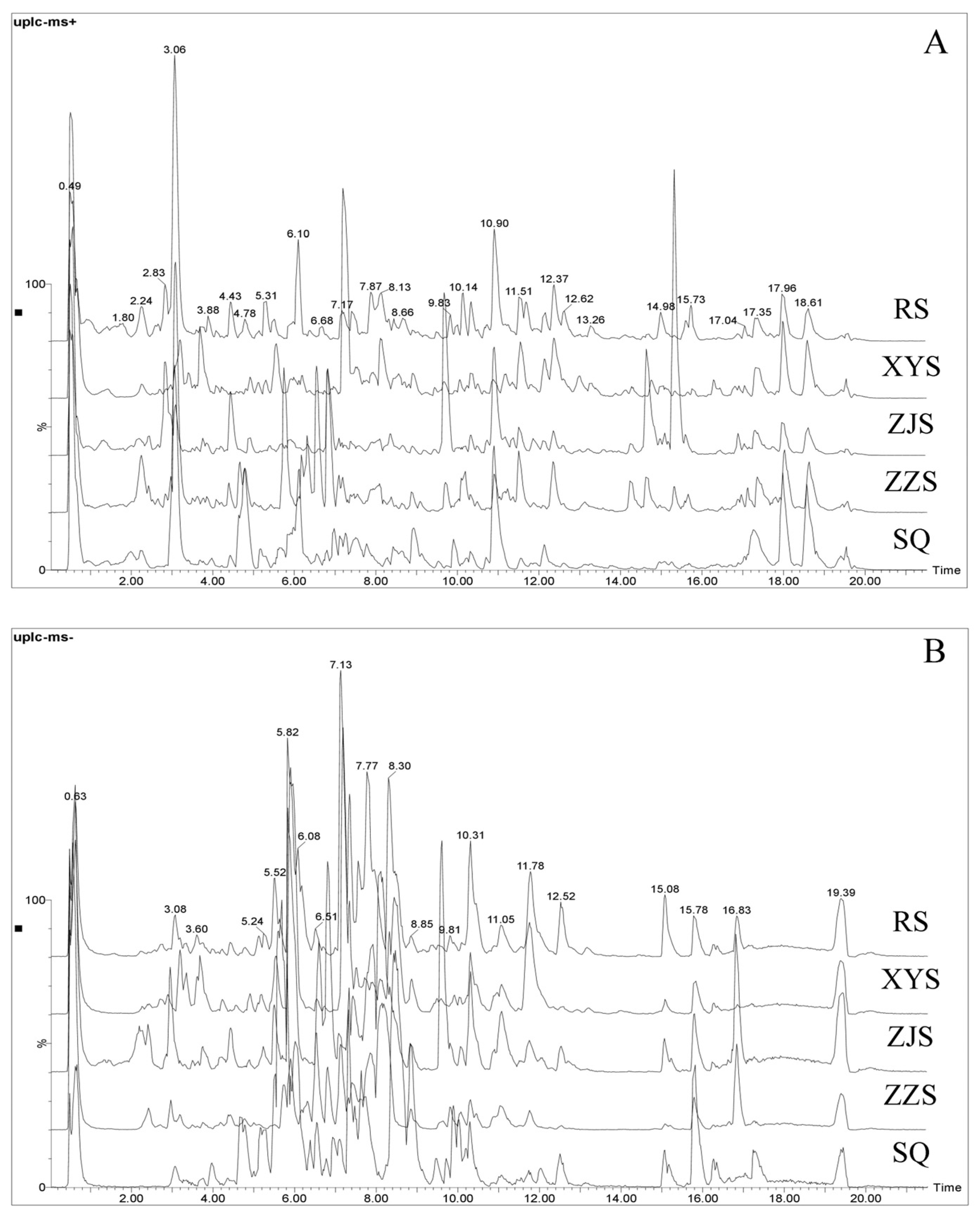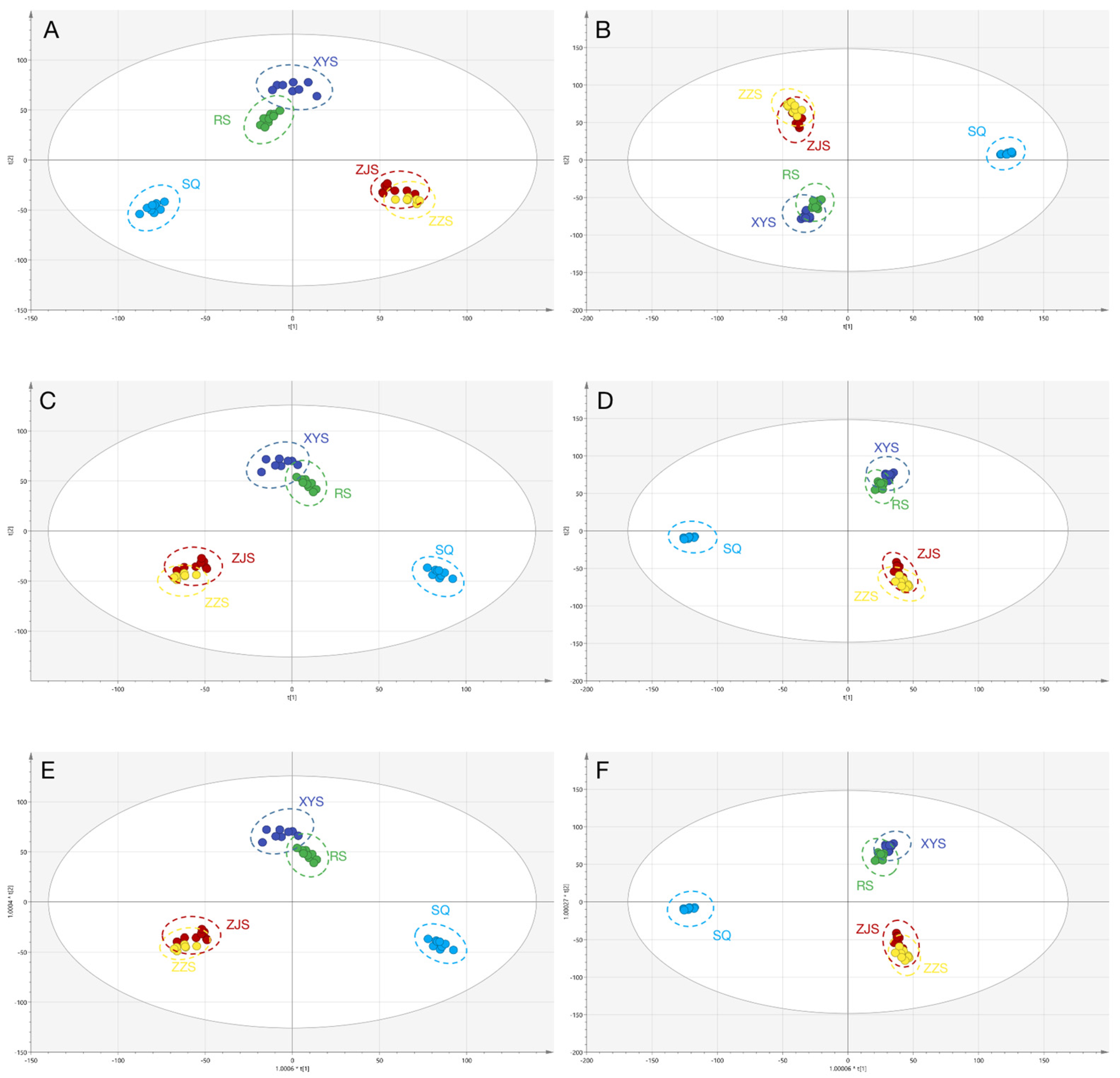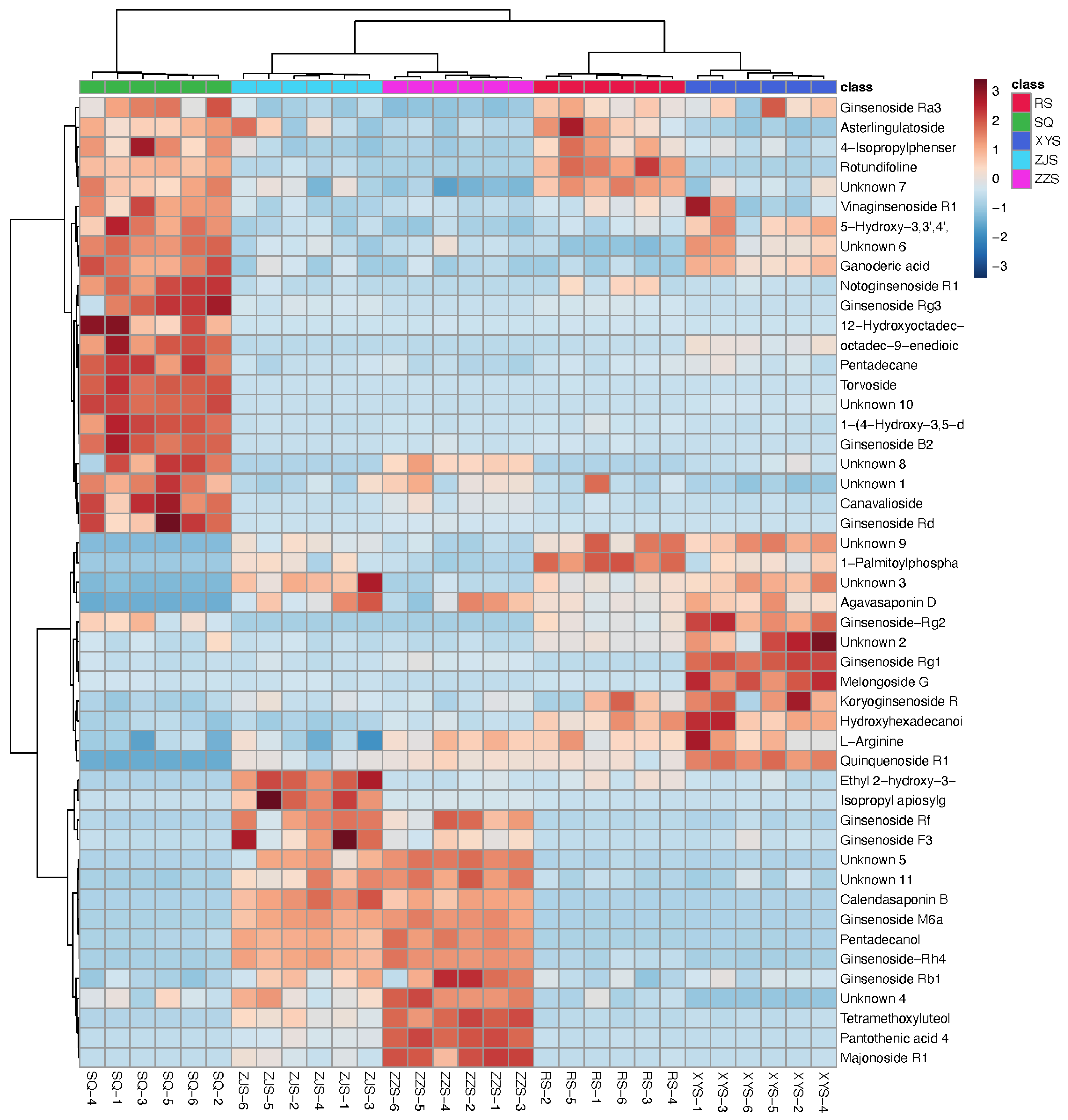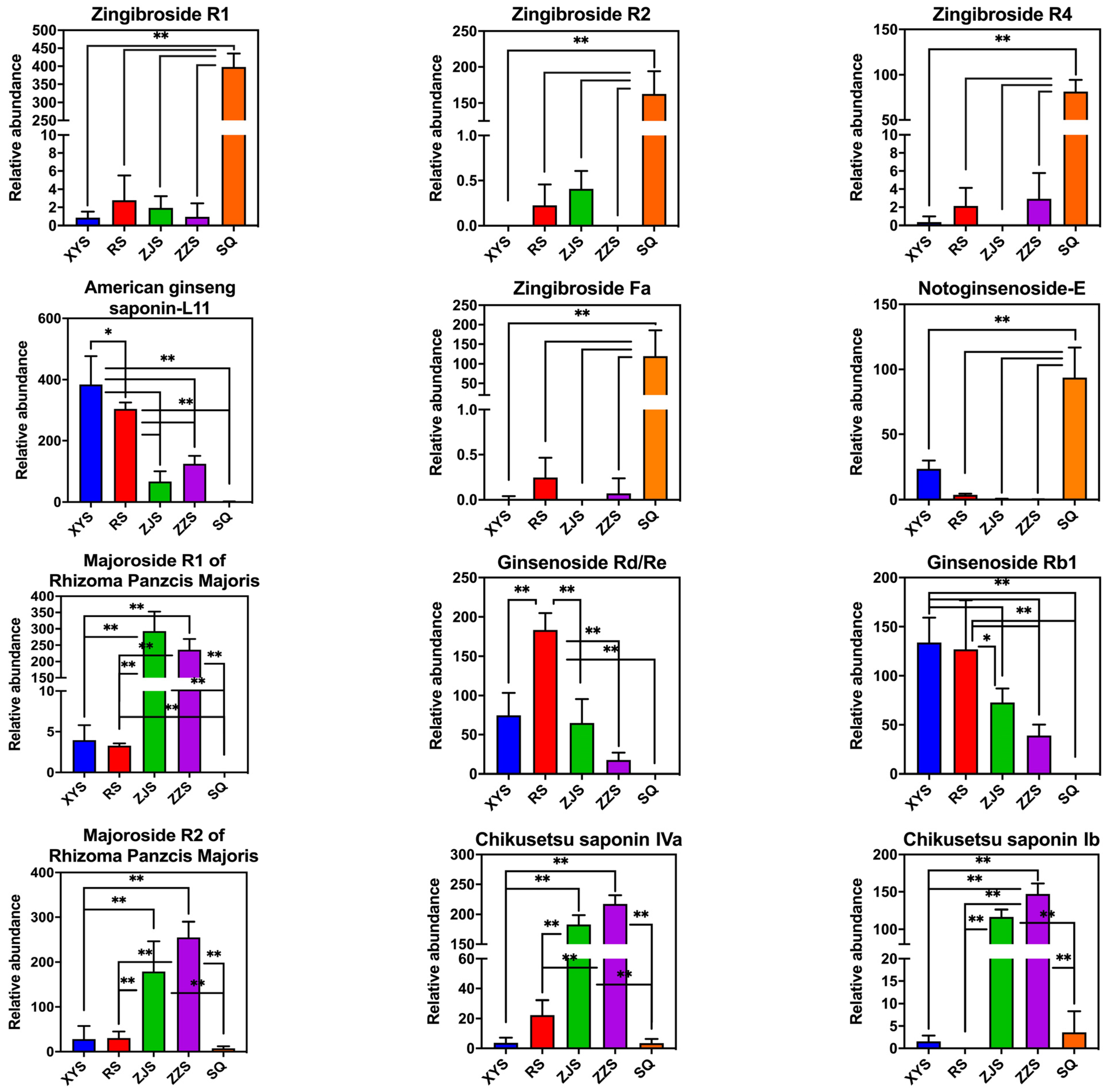Untargeted Metabolomic Analysis and Chemometrics to Identify Potential Marker Compounds for the Chemical Differentiation of Panax ginseng, P. quinquefolius, P. notoginseng, P. japonicus, and P. japonicus var. major
Abstract
1. Introduction
2. Results and Discussion
2.1. Optimization of a UPLC-QTOF-MS Approach for the Enhanced Profiling and Characterization of Metabolites Simultaneously from RS, XYS, SQ, ZJS, and ZZS
2.2. Multivariate Analysis for UPLC-QTOF-MS Results and Selection of Target Ion
3. Materials and Methods
3.1. Reagents and Material
3.2. Sample Preparation
3.3. UPLC/QTOF-MS Analysis
3.4. Multivariate Analysis
4. Conclusions
Author Contributions
Funding
Institutional Review Board Statement
Informed Consent Statement
Data Availability Statement
Conflicts of Interest
Sample Availability
Abbreviations List
| VIP | variable importance in projection |
| RS | P. ginseng |
| XYS | P. quinquefolius |
| SQ | P. notoginseng |
| ZJS | P. japonicus |
| ZZS | P. japonicus var. major |
| TCM | traditional Chinese medicine |
| PPD | protopanaxadiol |
| PPT | protopanaxatriol |
| OCT | ocotillol |
| OA | oleanane |
| PCA | principal component analysis |
| PLS-DA | supervised principal component analysis |
| OPLS-DA | orthogonal partial least squares discrimination analysis |
| HCA | hierarchical clustering analysis |
References
- Jee, H.S.; Chang, K.H.; Park, S.H.; Kim, K.T.; Paik, H.D. Morphological characterization, chemical components, and biofunctional activities of Panax ginseng, Panax quinquefolium, and Panax notoginseng roots: A comparative study. Food Rev. Int. 2014, 30, 91–111. [Google Scholar] [CrossRef]
- Baeg, I.H.; So, S.H. The world ginseng market and the ginseng (Korea). J. Ginseng Res. 2013, 37, 1–7. [Google Scholar] [CrossRef] [PubMed]
- Li, M.; Hua, S.; Huang, X.; Yue, H.; Chen, C.; Liu, S. Non-targeted metabonomics to investigate the differences in the properties of ginseng and American ginseng based on rapid resolution liquid chromatography coupled with quadrupole-time-of-flight mass spectrometry. J. Sep. Sci. 2021, 44, 3497–3505. [Google Scholar] [CrossRef] [PubMed]
- Yang, B.R.; Yuen, S.C.; Fan, G.Y.; Cong, W.H.; Leung, S.W.; Lee, S.M. Identification of certain Panax species to be potential substitutes for Panax notoginseng in hemostatic treatments. Pharmacol. Res. 2018, 134, 1–15. [Google Scholar] [CrossRef]
- Fu, J.; Pang, J.; Zhao, X.; Han, J. The Quantitative Ideas and Methods in Assessment of Four Properties of Chinese Medicinal Herbs. Cell Biochem. Biophys. 2015, 71, 1307–1312. [Google Scholar] [CrossRef]
- Liu, L.; Xu, F.R.; Wang, Y.Z. Traditional uses, chemical diversity and biological activities of Panax L. (Araliaceae): A review. J. Ethnopharmacol. 2020, 263, 112792. [Google Scholar] [CrossRef]
- Kim, S.; Shin, B.K.; Lim, D.K.; Yang, T.J.; Lim, J.; Park, J.H.; Kwon, S.W. Expeditious discrimination of four species of the Panax genus using direct infusion-MS/MS combined with multivariate statistical analysis. J. Chromatogr. B Analyt. Technol. Biomed. Life Sci. 2015, 1002, 329–336. [Google Scholar] [CrossRef]
- Liu, H.; Lu, X.; Hu, Y.; Fan, X. Chemical constituents of Panax ginseng and Panax notoginseng explain why they differ in therapeutic efficacy. Pharmacol. Res. 2020, 161, 105263. [Google Scholar] [CrossRef]
- Yang, F.; Chen, B.; Jiang, M.; Wang, H.; Hu, Y.; Wang, H.; Xu, X.; Gao, X.; Yang, W. Integrating Enhanced Profiling and Chemometrics to Unveil the Potential Markers for Differentiating among the Leaves of Panax ginseng, P. quinquefolius, and P. notoginseng by Ultra-High Performance Liquid Chromatography/Ion Mobility-Quadrupole Time-of-Flight Mass Spectrometry. Molecules 2022, 27, 5549. [Google Scholar]
- In, G.; Seo, H.K.; Park, H.W.; Jang, K.H. A Metabolomic Approach for the Discrimination of Red Ginseng Root Parts and Targeted Validation. Molecules 2017, 22, 471. [Google Scholar] [CrossRef]
- Zhu, H.; Lin, H.; Tan, J.; Wang, C.; Wang, H.; Wu, F.; Dong, Q.; Liu, Y.; Li, P.; Liu, J. UPLC-QTOF/MS-Based Nontargeted Metabolomic Analysis of Mountain- and Garden-Cultivated Ginseng of Different Ages in Northeast China. Molecules 2018, 24, 33. [Google Scholar] [CrossRef]
- Shin, J.S.; Park, H.W.; In, G.; Seo, H.K.; Won, T.H.; Jang, K.H.; Cho, B.G.; Han, C.K.; Shin, J. Metabolomic Approach for Discrimination of Four- and Six-Year-Old Red Ginseng (Panax ginseng) Using UPLC-QToF-MS. Chem. Pharm. Bull. 2016, 64, 1298–1303. [Google Scholar] [CrossRef]
- Hou, M.; Wang, R.; Zhao, S.; Wang, Z. Ginsenosides in Panax genus and their biosynthesis. Acta Pharm. Sin. B 2021, 11, 1813–1834. [Google Scholar] [PubMed]
- Shi, Z.Y.; Zeng, J.Z.; Wong, A.S.T. Chemical Structures and Pharmacological Profiles of Ginseng Saponins. Molecules 2019, 24, 2443. [Google Scholar] [CrossRef] [PubMed]
- Yue, J.; Zuo, Z.; Huang, H.; Wang, Y. Application of Identification and Evaluation Techniques for Ethnobotanical Medicinal Plant of Genus Panax: A Review. Crit. Rev. Anal. Chem. 2021, 51, 373–398. [Google Scholar] [CrossRef] [PubMed]
- Wang, X.J.; Xie, Q.; Liu, Y.; Jiang, S.; Li, W.; Li, B.; Wang, W.; Liu, C.X. Panax japonicus and chikusetsusaponins: A review of diverse biological activities and pharmacology mechanism. Chin. Herb. Med. 2021, 13, 64–77. [Google Scholar]
- Du, Z.; Li, J.; Zhang, X.; Pei, J.; Huang, L. An Integrated LC-MS-Based Strategy for the Quality Assessment and Discrimination of Three Panax Species. Molecules 2018, 23, 2988. [Google Scholar] [CrossRef]
- Liu, J.; Wang, H.D.; Yang, F.F.; Chen, B.X.; Li, X.; Huang, Q.X.; Li, J.; Li, X.Y.; Li, Z.; Yu, H.S.; et al. Multi-level fingerprinting and cardiomyocyte protection evaluation for comparing polysaccharides from six Panax herbal medicines. Carbohydr. Polym. 2022, 277, 118867. [Google Scholar] [CrossRef]
- Guo, D.; Wu, W.; Ye, M.; Liu, X.; Cordell, G. A holistic approach to the quality control of traditional Chinese medicines. Science 2015, 347, S29–S31. [Google Scholar]
- Alseekh, S.; Aharoni, A.; Brotman, Y.; Contrepois, K.; D’Auria, J.; Ewald, J.C.; Fraser, P.D.; Giavalisco, P.; Hall, R.D.; Heinemann, M.; et al. Mass spectrometry-based metabolomics: A guide for annotation, quantification and best reporting practices. Nat. Methods 2021, 18, 747–756. [Google Scholar]
- Ren, J.L.; Zhang, A.H.; Kong, L.; Han, Y.; Yan, G.L.; Sun, H.; Wang, X.J. Analytical strategies for the discovery and validation of quality-markers of traditional Chinese medicine. Phytomedicine 2020, 67, 153165. [Google Scholar] [CrossRef] [PubMed]
- Li, M.M.; Wang, Y.K.; Sheng, Y.H.; Huang, X.; Yue, H.; Liu, S.Y. Application of UPLC-QTOF-MS non-targeted metabonomics in mechanism study of property differences of ginseng and American ginseng. Zhongguo Zhong Yao Za Zhi 2021, 46, 5930–5935. [Google Scholar] [PubMed]
- Fan, M.; Fan, Y.; Rao, Z.; Li, Y.; Qian, H.; Zhang, H.; Wu, G.; Qi, X.; Wang, L. Comparative investigation on metabolite changes in ‘wu mi’ production by Vaccinium bracteatum Thunb. leaves based on multivariate data analysis using UPLC-QToF-MS. Food Chem. 2019, 286, 146–153. [Google Scholar] [CrossRef] [PubMed]
- Yoon, D.; Shin, W.C.; Oh, S.M.; Choi, B.R.; Young Lee, D. Integration of multiplatform metabolomics and multivariate analysis for geographical origin discrimination of Panax ginseng. Food Res. Int. 2022, 159, 111610. [Google Scholar] [CrossRef]
- Wang, L.; Huang, Y.; Yin, G.; Wang, J.; Wang, P.; Chen, Z.Y.; Wang, T.; Ren, G. Antimicrobial activities of Asian ginseng, American ginseng, and notoginseng. Phytother. Res. 2020, 34, 1226–1236. [Google Scholar] [CrossRef]
- Shim, H.; Waminal, N.E.; Kim, H.H.; Yang, T.J. Dynamic evolution of Panax species. Genes Genom. 2021, 43, 209–215. [Google Scholar] [CrossRef] [PubMed]
- Du, Y.; Fan, P.; Zou, L.; Jiang, Y.; Gu, X.; Yu, J.; Zhang, C. Serum Metabolomics Study of Papillary Thyroid Carcinoma Based on HPLC-Q-TOF-MS/MS. Front. Cell Dev. Biol. 2021, 9, 593510. [Google Scholar] [CrossRef]
- Meng, Q.; Zhong, Y.M.; Guo, X.L.; FENG, Y.F. Rapid Identification and Preliminary Study of Fragmentation Regularity of Saponins Components of Ginseng. J. Chin. Med. Mater. 2013, 36, 240–245. [Google Scholar]
- Wang, Q.; Rui, Y.F.; Zhong, Y.M.; Guo, J. Rapid Analysis of Saponins in Panax notoginseng by UPLC/Q-TOF MS. Nat. Prod. Res. Dev. 2014, 26, 1233–1239. [Google Scholar]
- Fang, L.X.; Xiong, A.Z.; Wang, R.; Ji, S.; Yang, L.; Wang, Z.T. A strategy for screening and identifying mycotoxins in herbal medicine using ultra-performance liquid chromatography with tandem quadrupole time-of-flight mass spectrometry. J. Sep. Sci. 2013, 36, 3115–3122. [Google Scholar] [CrossRef]
- Wang, F.X.; Yuan, J.C.; Kang, L.P.; Pang, X.; Yan, R.Y.; Zhao, Y.; Zhang, J.; Sun, X.G.; Ma, B.P. An efficient approach to identify different chemical markers between fibrous root and rhizome of Anemarrhena asphodeloides by ultra high-performance liquid chromatography quadrupole time-of-flight tandem mass spectrometry with multivariate statistical analysis. J. Pharm. Biomed. Anal. 2016, 129, 105–116. [Google Scholar] [PubMed]
- Robotti, E.; Marengo, E. Chemometric Multivariate Tools for Candidate Biomarker Identification: LDA, PLS-DA, SIMCA, Ranking-PCA. Methods Mol. Biol. 2016, 1384, 237–267. [Google Scholar] [PubMed]
- Qiu, S.; Yang, W.Z.; Yao, C.L.; Qiu, Z.D.; Shi, X.J.; Zhang, J.X.; Hou, J.J.; Wang, Q.R.; Wu, W.Y.; Guo, D.A. Nontargeted metabolomic analysis and “commercial-homophyletic” comparison-induced biomarkers verification for the systematic chemical differentiation of five different parts of Panax ginseng. J. Chromatogr. A 2016, 1453, 78–87. [Google Scholar] [CrossRef] [PubMed]







| NO. | Ion Mode | Adducts | VIP | tR (min) | Observed m/z | Error ppm | Formula | Identification | RS | XYS | ZJS | ZZS | SQ |
|---|---|---|---|---|---|---|---|---|---|---|---|---|---|
| 1 | + | M+H | 5.43 | 0.49 | 175.1173 | 9 | C6H14N4O2 | L-Arginine | + | ++ | + | + | + |
| 2 | - | M-H | 4.82 | 0.6 | 387.1074 | 3 | C20H20O8 | 5-Hydroxy-3,3′,4′,7,8-pentamethoxyflavone | + | + | + | + | - |
| 3 | - | M-H | 5.94 | 0.61 | 341.1003 | 8 | C19H18O6 | Tetramethoxyluteolin | + | + | ++ | +++ | + |
| 4 | + | M+H-2H2O | 5.95 | 0.64 | 360.1462 | 2 | C19H25NO8 | Ethyl 2-hydroxy-3-(3-indolyl)propanoate glucoside | + | ++ | + | + | ++ |
| 5 | + | M+NH4 | 5.02 | 2.41 | 372.1857 | 2 | C14H26O10 | Isopropyl apiosylglucoside | - | - | + | + | - |
| 6 | + | / | 9.69 | 2.81 | 322.2084 | / | / | Unknown 1 | + | + | +++ | + | - |
| 7 | + | / | 8.56 | 2.94 | 386.1982 | / | / | Unknown 2 | - | - | ++ | - | - |
| 8 | + | / | 9.72 | 3.07 | 363.169 | / | / | Unknown 3 | ++ | + | + | ++ | +++ |
| 9 | + | / | 4.35 | 3.68 | 400.2183 | / | / | Unknown 4 | - | + | - | - | - |
| 10 | + | M+CH3OH+H | 5.67 | 3.82 | 579.2993 | 3 | C26H42O12 | Canavalioside | + | + | + | + | - |
| 11 | + | M+H | 4.42 | 4.42 | 407.2007 | 14 | C22H30O7 | 1-(4-Hydroxy-3,5-dimethoxyphenyl)-7-(4-hydroxy-3-methoxyphenyl)-3,5-heptanediol | + | - | + | ++ | + |
| 12 | + | M+NH4-H2O | 6.08 | 4.65 | 381.1834 | 7 | C15H27NO10 | Pantothenic acid 4′-O-b-D-glucoside | - | - | - | - | + |
| 13 | + | M+H-2H2O | 8.07 | 4.78 | 365.1871 | 0 | C22H28N2O5 | Rotundifoline | - | - | - | - | ++ |
| 14 | - | / | 5.31 | 4.78 | 262.1171 | / | / | Unknown 5 | - | - | - | - | ++ |
| 15 | - | M-H | 4.08 | 5.5 | 961.5382 | 0 | C48H82O19 | Ginsenoside M6a | - | - | - | - | + |
| 16 | - | M-H | 7.73 | 5.63 | 931.5192 | 9 | C47H80O18 | Notoginsenoside R1 | - | - | - | - | +++ |
| 17 | + | M+H | 8.57 | 5.73 | 817.4825 | 15 | C42H72O15 | Majonoside R1 | - | - | + | ++ | - |
| 18 | - | M-H | 4.91 | 5.83 | 799.4801 | 5 | C42H71O14 | Ginsenoside Rg1 | - | - | - | - | ++ |
| 19 | - | / | 7.13 | 5.88 | 991.5361 | / | / | Unknown 6 | ++ | +++ | + | ++ | - |
| 20 | - | M+FA-H | 4.91 | 6.05 | 845.4891 | 2 | C43H75O15 | Ginsenoside Rg2 | - | - | - | + | + |
| 21 | + | M+NH4 | 7.29 | 6.06 | 904.5162 | 11 | C45H74O17 | Melongoside G | + | - | + | - | + |
| 22 | + | M+ACN+Na | 6.57 | 6.31 | 580.3255 | 2 | C30H44O7 | Ganoderic acid | - | - | + | + | - |
| 23 | + | / | 8.5 | 6.8 | 817.4781 | / | / | Unknown 7 | - | - | ++ | ++ | - |
| 24 | - | M+Hac-H | 8.03 | 6.81 | 861.4695 | 18 | C41H70O15 | Vinaginsenoside R14 | - | - | +++ | ++ | - |
| 25 | + | M+2ACN+H | 4.01 | 7 | 1259.6813 | 22 | C57H92O25 | Asterlingulatoside D | + | - | - | - | + |
| 26 | - | M-H | 4.46 | 7.03 | 1239.6458 | 6 | C59H100O27 | Ginsenoside Ra3 | - | - | - | - | + |
| 27 | + | M+2H | 5.6 | 7.16 | 563.3038 | 4 | C54H92O24 | Koryoginsenoside Rg2 | - | - | + | + | - |
| 28 | - | M+FA-H | 8.19 | 7.16 | 845.4742 | 19 | C43H75O15 | Ginsenoside Rf | +++ | +++ | + | + | - |
| 29 | - | M-H | 4.48 | 7.3 | 769.4709 | 5 | C41H70O13 | Ginsenoside F3 | - | - | - | - | + |
| 30 | - | M+F | 4.53 | 7.35 | 1193.5899 | 25 | C56H90O27 | Agavasaponin D | ++ | ++ | + | + | - |
| 31 | + | M+NH4 | 4.08 | 7.44 | 1126.6355 | 1 | C54H92O23 | Ginsenoside Rb1 | - | + | - | - | + |
| 32 | - | M-H | 4.06 | 7.65 | 783.4876 | 3 | C42H72O13 | Ginsenoside Rg3 | - | - | - | - | + |
| 33 | - | M+Na-2H | 5.31 | 7.82 | 925.4683 | 10 | C45H76O18 | Torvoside | - | - | + | + | - |
| 34 | + | M+NH4 | 5.11 | 8.13 | 1168.6486 | 1 | C56H94O24 | Quinquenoside R1 | - | + | - | - | - |
| 35 | - | / | 6.36 | 8.13 | 793.4239 | / | / | Unknown 8 | - | - | ++ | ++ | - |
| 36 | - | M+Hac-H | 6.35 | 8.36 | 1031.5343 | 27 | C48H76O20 | Calendasaponin B | ++ | + | + | - | - |
| 37 | + | M+NH4 | 5.02 | 8.43 | 964.582 | 2 | C48H82O18 | Ginsenoside B2 | - | + | - | - | + |
| 38 | - | M-H | 7.22 | 8.45 | 945.5336 | 9 | C48H81O18 | Ginsenoside Rd | - | - | - | - | +++ |
| 39 | + | / | 4.69 | 8.66 | 1050.5853 | / | / | Unknown 9 | + | - | - | - | + |
| 40 | + | M+NH4 | 5.47 | 10.32 | 330.2622 | 5 | C18H32O4 | octadec-9-enedioic acid | + | + | - | - | + |
| 41 | + | M+NH4 | 5.35 | 10.88 | 316.2813 | 10 | C18H34O3 | 12-Hydroxyoctadec-9-enoic acid | ++ | - | + | - | + |
| 42 | - | M-H+HCOONa | 4.58 | 11.78 | 295.2235 | 7 | C15H32O | Pentadecanol | + | + | - | - | - |
| 43 | + | / | 5.51 | 12.1 | 622.3771 | / | C36H60O8 | Ginsenoside Rh4 | + | + | - | - | + |
| 44 | + | M+H | 4.07 | 12.37 | 496.3377 | 4 | C24H50NO7P | 1-Palmitoylphosphatidylcholine | + | + | + | + | - |
| 45 | + | / | 6.69 | 14.64 | 378.2217 | / | / | Unknown 10 | - | - | ++ | ++ | - |
| 46 | - | M-H | 4.33 | 15.07 | 271.2245 | 12 | C16H32O3 | Hydroxyhexadecanoic acid | + | - | - | - | + |
| 47 | + | M+H | 9.95 | 15.32 | 380.236 | 7 | C23H29N3O2 | 4-Isopropylphenserine | - | + | +++ | ++ | - |
| 48 | - | M-H+HCOONa | 5.25 | 15.79 | 279.2294 | 4 | C15H32 | Pentadecane | + | + | + | + | ++ |
| 49 | - | / | 6.46 | 16.82 | 833.5103 | / | / | Unknown 11 | - | - | ++ | +++ | - |
Disclaimer/Publisher’s Note: The statements, opinions and data contained in all publications are solely those of the individual author(s) and contributor(s) and not of MDPI and/or the editor(s). MDPI and/or the editor(s) disclaim responsibility for any injury to people or property resulting from any ideas, methods, instructions or products referred to in the content. |
© 2023 by the authors. Licensee MDPI, Basel, Switzerland. This article is an open access article distributed under the terms and conditions of the Creative Commons Attribution (CC BY) license (https://creativecommons.org/licenses/by/4.0/).
Share and Cite
Ji, R.; Garran, T.A.; Luo, Y.; Cheng, M.; Ren, M.; Zhou, X. Untargeted Metabolomic Analysis and Chemometrics to Identify Potential Marker Compounds for the Chemical Differentiation of Panax ginseng, P. quinquefolius, P. notoginseng, P. japonicus, and P. japonicus var. major. Molecules 2023, 28, 2745. https://doi.org/10.3390/molecules28062745
Ji R, Garran TA, Luo Y, Cheng M, Ren M, Zhou X. Untargeted Metabolomic Analysis and Chemometrics to Identify Potential Marker Compounds for the Chemical Differentiation of Panax ginseng, P. quinquefolius, P. notoginseng, P. japonicus, and P. japonicus var. major. Molecules. 2023; 28(6):2745. https://doi.org/10.3390/molecules28062745
Chicago/Turabian StyleJi, Ruifeng, Thomas Avery Garran, Yilu Luo, Meng Cheng, Mengyue Ren, and Xiuteng Zhou. 2023. "Untargeted Metabolomic Analysis and Chemometrics to Identify Potential Marker Compounds for the Chemical Differentiation of Panax ginseng, P. quinquefolius, P. notoginseng, P. japonicus, and P. japonicus var. major" Molecules 28, no. 6: 2745. https://doi.org/10.3390/molecules28062745
APA StyleJi, R., Garran, T. A., Luo, Y., Cheng, M., Ren, M., & Zhou, X. (2023). Untargeted Metabolomic Analysis and Chemometrics to Identify Potential Marker Compounds for the Chemical Differentiation of Panax ginseng, P. quinquefolius, P. notoginseng, P. japonicus, and P. japonicus var. major. Molecules, 28(6), 2745. https://doi.org/10.3390/molecules28062745





